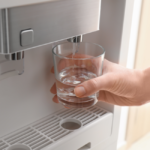In almost 20 years, the EPA has not added any new contaminants to the list of toxic chemicals covered by the Safe Drinking Water Act!
The regulatory system meant to ensure the safety of America’s drinking water is broken. The inexcusable failure of the federal government’s responsibility to protect public health means there are no legal limits for more than 160 unregulated contaminants in U.S. tap water. For some other chemicals, the EPA’s Maximum Contaminant Levels, or MCLs, haven’t been updated in almost 50 years.
Here’s the dirty secret about government drinking water standards: Legal doesn’t necessarily mean safe.
The vast majority of the nation’s drinking water supplies get a passing grade from federal and state regulatory agencies. While many of the 278 contaminants detected by local utilities’ tests are found to be under the Safe Drinking Water Act’s legal limit, many are also well above levels that scientific studies have found to pose health risks.
Europe has very different drinking water standards and has listed over 1,000 chemicals that the US still allows. A great example of the difference in the US vs EU regulations relates to the use of lead based paints. These paints were banned in France, Belgium and Austria in 1909. Much of Europe followed suit before 1940. It took the U.S. until 1978 to make this move, even though health experts had, for decades, recognized the hazards of lead exposure.
There is a simple reason why the US and Europe differ so greatly in regard to the EU’s chemicals management and drinking water standards — and one that clearly distinguishes the EU’s approach from that of the U.S. federal government — is what’s called the precautionary principle.
This principle says that when there is substantial, credible evidence of danger to human or environmental health, protective action should be taken despite continuing scientific uncertainty.
In contrast, the U.S. federal government’s approach to chemicals management sets a very high bar for the proof of harm that must be demonstrated before regulatory action is taken. Since there are thousands of chemicals it’s nearly impossible to provide enough research done to force restrictions.
This is true of the U.S. Toxic Substances Control Act, the federal law that regulates chemicals used commercially in the U.S. The European law regulating chemicals in commerce, known as REACH (Registration, Evaluation, Authorisation and Restriction of Chemicals), requires manufacturers to submit a full set of toxicity data to the European Chemical Agency before a chemical can be approved for use. U.S. federal law requires such information to be submitted for new chemicals, but leaves a huge gap in terms of what’s known about the environmental and health effects for chemicals already in use. Chemicals used in cosmetics or as food additives or pesticides are covered by other U.S. laws — but these laws, too, have high burdens for proof of harm and, like TSCA, do not incorporate a precautionary approach.
As the saying goes, you don’t miss your water till your well runs dry. And it’s easy to take your drinking water for granted. You turn on the tap and out it comes, plentiful and usually in compliance with government regulations.
The nation’s water supply is under assault from a toxic stew of pollutants most of which are legally used and dumped in landfills: the toxic fluorinated chemicals called PFAS, lead from old pipes, runoff from farmland that carries millions of tons of pesticides and fertilizer chemicals into rivers and streams, and many more.
Even for chemicals that are regulated, the legal limit is often hundreds of times higher than the health standards recommended by scientists and public health agencies. Too often, legal limits are based on what can be achieved cheaply, with little or no regard for public health. And water treatment facilities in many communities, especially in rural areas, are outdated, overloaded or underfunded, as urgently needed investments in water infrastructure get postponed year after year.
What should you do?
You can take steps to make sure you and your family are drinking the cleanest, safest water possible. The right home water filter system can dramatically reduce the presence of many contaminants.
Also look beyond your own tap and stop taking safe drinking water for granted. Get informed about what’s coming out of your tap and the contaminants fouling streams and rivers. Consider joining – or starting – a local citizens’ group advocating for clean water, like the Merrimack River Watershed Council https://merrimack.org/contact/ and others.




